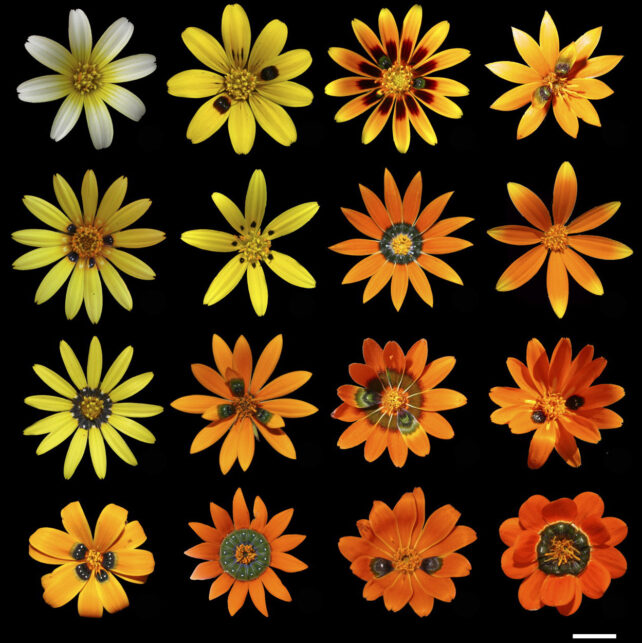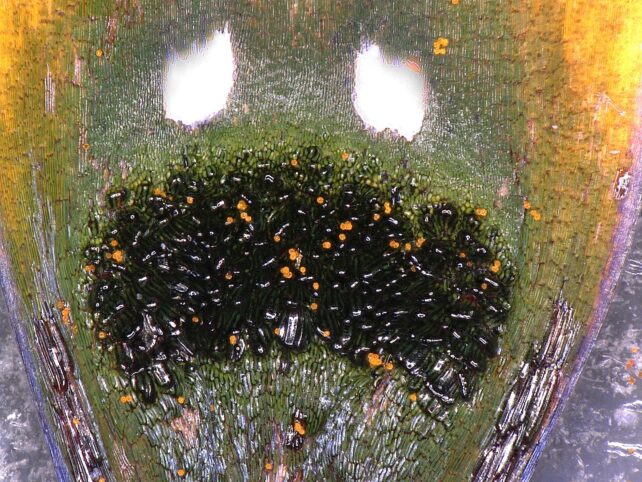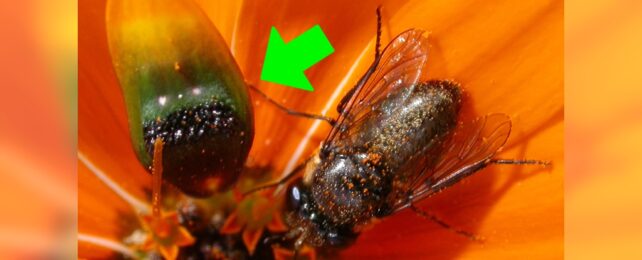A flower's ability to mimic the sexually attractive traits of pollinators to lure them to its nectar has long fascinated scientists.
Flowers can't buy glasses and a wig to create a disguise, so how they came to pull off such convincing dupes, using only an existing toolkit of DNA, is baffling.
Orchids are the most infamous flower for insect mimicry, and can look and smell irresistible to an unwitting insect Casanova, whose brief tryst among the petals leaves the insect laden with the Orchid's pollen, that it inevitably spreads to other flowers.
Orchids evolved this trait so long ago, and with such domineering success, that any individuals without these traits are long gone.
This is why scientists looked to the South African daisy Gorteria diffusa, whose sexual mimicry emerged pretty recently in evolutionary history, and isn't consistent across all flowers in the species.
This daisy's petals range from pale yellow to bright red-orange, some with spots that form a circle around the flower's center.
The appearance of these flowers varies greatly, and in some, the spots have transformed into green-black bumps that, to a fly, look exactly like it's female mate, awaiting seductively upon the petals.

The evolution of this species' variety of features was recently mapped to determine the order in which the traits evolved to culminate in such a convincing deception: it revealed color first, then random positioning, then texture.
New research, led by evolutionary biologist Roman Kellenberger from the University of Cambridge, investigates how three sets of genes, that once had nothing to do with appealing to horny flies, have become part of its salacious strategy.
"This daisy didn't evolve a new 'make a fly' gene," plant biologist and senior author Beverley Glover from the University of Cambridge says.
"It brought together existing genes, which already do other things in different parts of the plant, to make a complicated spot on the petals that deceives male flies."
One of these genes moves iron around the plant, another makes root hairs grow, and a third controls when flowers are made.
The iron-moving genes create spots that guide pollinators to the flower's center for a nectar reward, a tried-and-true pollination strategy flowers relied on long before sexual mimicry arose.
The combination of resulting pigments (carotenoids, which create the yellow-orange color, and the dark violet-blue of anthocyanins) is a blue-green black tint – the exact color we associate with a fly's carapace.

A set of genes usually involved in limiting flower production was repurposed next, as an "off switch" for the nectar-guiding spots, making the 'fake flies' appear in apparently random positions on the petals.
If the strategy for attracting pollinators is advertising the flower's nectar, then a clear ring of spots is kind of like a billboard for parking space. But when the strategy is sexual mimicry, it seems that for flies, less is more.
The gene sequence usually involved in the production of a plant's root hairs is responsible for really bringing the dupe to life, causing the three dimensional shape and texture of the daisy's fly-like petal spots.
The protein this gene produces, EXPA, relaxes the usually rigid plant cell walls, leading to "irreversible cell expansion". In the petal, this protein makes the existing hairs expand, giving its surface texture.
This gene was almost entirely out of action in developing leaves and unspotted florets; it was expressed moderately in developing roots; and highly in developing spotted flowers.
But the researchers know this gene is involved in 'inflating' what would otherwise be more like a cardboard cutout of a female fly, because it's only expressed in the petals of the most convincing flowers, and even among these, expression is almost entirely absent in the petals without spots or bumps.
You can imagine how much more action the flowers with this 3D upgrade must be getting.
"Male flies don't stay long on flowers with simple spots, but they're so convinced by these fake flies that they spend extra time trying to mate, and rub off more pollen onto the flower – helping to pollinate it," Kellenberger says.
Bringing together three existing sets of genes, it seems, has created an evolutionary shortcut for these masters of disguise.
This study has been published in Current Biology.
